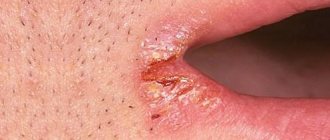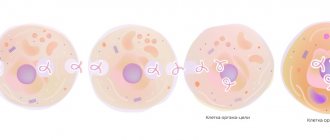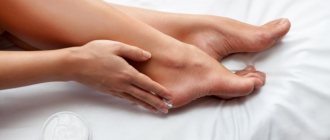Cracks in the corners of the mouth are the main symptom of angulitis. This is a disease of the mucous membrane and skin that develops under the influence of streptococci or yeast-like fungi. Diabetes mellitus, problems with bite, lack of vitamin B2 and even long-term antibiotic therapy also contribute to the occurrence of cracks. Why is the skin in the corners of the mouth prone to cracking, how to neutralize and prevent the development of the process in the future?
General characteristics of the condition
Painful cracks around the mouth are colloquially called jams. Zaeda is one of the forms of stomatitis (damage to the oral mucosa) caused by streptococci or yeast-like fungi of the genus Candida. In some cases, doctors diagnose mixed infection (angular stomatitis).
The following angulitis are distinguished: allergic (when using lipstick or other cosmetics), microbial (streptococcal, candidiasis, etc.) and post-traumatic (postoperative, post-manipulation, etc.). Microbial angulitis most often occurs in patients with diabetes mellitus (streptococcal) or in HIV-infected people (candidomycosis). Microbial angulitis in children can occur due to intestinal dysbiosis, vitamin deficiency, decreased immunity and other diseases. Post-traumatic (postoperative) angulitis is cracks in the skin and mucous membranes (linear tears in the skin or mucous membrane) in the area of the corner of the mouth, resulting from excessive (excessive) stretching after intraoral surgical dental operations (removal of dystopic or impacted wisdom teeth) or manipulations associated with treatment of wisdom teeth. Almost after every removal of an impacted or dystopic wisdom tooth, maxillary sinusotomy or other surgical interventions that require wide opening of the mouth, damage (by stretching) to the surface layers of the skin and mucous membrane in the area of the corner of the mouth occurs, i.e. post-traumatic (postoperative) angulitis.
Morphological features
Streptococcal angulitis most often develops in patients of the younger age category. First, a small bubble appears in the corners of the mouth, covered with a thin film. Later, erosion forms at the site of the bubble, covered with a crust of congealed blood and purulent masses. When the blister is opened, moist red skin with traces of minor bleeding is exposed. You can often find a crack in the center of the bubble. Approximately 1-2 hours after opening, the skin again becomes covered with a dense crust.
Content:
- General characteristics of the condition
- Possible reasons for development
- Features of therapy and prevention
Streptococcal infection of the mucous membrane is accompanied by discomfort and pain when opening the mouth.
Seizures of fungal origin are slightly different from streptococcal ones. Initially, a varnish-red erosion forms on the mucosa, surrounded by an additional layer of epithelium. Sometimes erosion is covered with a grayish coating. A specific crust does not form in case of candidiasis angulitis. Most often, the crack is masked by an overhanging skin fold and has a chronic, relapsing course.
Complications of lip jams
At the first, initial stage, the superficial layers of the mucous skin are affected and timely treatment of the jam leads to a quick recovery. But if left untreated, the lesion spreads to the deeper layers of the skin with the formation of a deep crack in the corners of the lips and the participation of lymphatic capillaries. The lesion can spread to neighboring areas of the skin, new cracks form, they combine into a large wound, which requires separate and special treatment.
Possible reasons for development
The appearance of a jam indicates not only infection or internal pathological processes, but also the bad habits of the person himself. Regularly licking your lips is a ritual that some people find extremely difficult to break. It is important to understand that regular exposure to saliva, which contains billions of bacteria, has a detrimental effect on the mucous membranes. If a crack has already formed, licking the lips interferes with regeneration and further fuels the infection.
Neglecting the rules of personal hygiene is also fraught with the development of cracks in the corners of the mouth. Possible causes include: microtraumas, lack of cleansing, dirt on the skin.
Eating in childhood most often indicates iron deficiency anemia. Therefore, all pediatricians advise immediately taking a blood test for iron, and not sinning on problems with the baby’s hygiene. The main thing is not to try to correct anemia on your own. Introducing meat and pomegranates in large quantities into the diet can only maintain the existing iron level, but not increase it. Noticed symptoms of anemia? Go to the doctor and undergo a comprehensive therapeutic course.
Cracks in the corners of the mouth can also be a symptom of:
- vitamin B2 deficiency;
- malocclusion;
- missing teeth or incorrectly selected dentures;
- allergic lesions of the oral cavity;
- caries;
- metabolic disorders;
- long-term treatment with strong medications.
What you need to know about chronic recurrent binge eating?
In some cases, therapy gives a short-term effect or does not affect the condition of cracks in the corners of the mouth at all. For frequently recurring seizures, the doctor must conduct a comprehensive diagnosis of the body, identify and eliminate the root cause. What diseases can chronic angulitis indicate?
- HIV. A weakened body becomes easy prey for pathogenic microbes. Most often, cracks cannot be treated, and the surrounding skin becomes covered with a white coating, becomes dry and inflamed.
- Tuberculosis, chronic infectious pathologies. Microtraumas occur due to fungus or mixed flora. Often, recurrent seizures are accompanied by increased night sweats and sudden changes in body temperature.
- Intestinal diseases. Failure of the functionality of the gastrointestinal tract is always associated with disruption of metabolic processes. Intestinal diseases impair the absorption of nutrients, including iron and B vitamins. The lack of these nutrients provokes a decrease in the protective function of the mucous membrane and the development of cracks.
- Diabetes. In diabetes mellitus, an imbalance of mucosal microorganisms occurs. Moreover, by-products of impaired glucose metabolism accumulate in tissues. The result is microtrauma of tissue with a characteristic white coating, which is hidden behind skin folds.
- Oncological diseases. Cancer suppresses the body's protective functions and consumes the lion's share of nutrients, which can lead to a lack of micro- and macroelements and anemia. Recurrent seizures may well be a symptom of a tumor in the oral cavity or gastrointestinal tract.
Symptoms of seizures in the corners of the mouth
Clinical manifestations and symptoms of the lesion depend on many factors and stages. It usually begins with redness of the skin in the corners of the mouth, peeling, and the appearance of bursting blisters. Areas of erosion appear on the mucous membrane and skin of the corner, which become covered with a crust, when ruptured, cracks of varying depths can form.
In areas of inflammation, constant itching is felt, pain appears when opening the mouth, pain when eating spicy food. It is especially typical that a sharp pain appears in the morning, after sleep, when you first open your mouth.
But in some rare cases, obvious pain symptoms are mild, especially in elderly people, or in people suffering from diabetes mellitus (when seizures appear as a consequence of candidal stomatitis).
Features of therapy and prevention
Best materials of the month
- Coronaviruses: SARS-CoV-2 (COVID-19)
- Antibiotics for the prevention and treatment of COVID-19: how effective are they?
- The most common "office" diseases
- Does vodka kill coronavirus?
- How to stay alive on our roads?
Therapy is based on eliminating the root cause of the seizure, but there are also general recommendations for caring for the affected skin. If the cracks are streptococcal in nature, ointments with antibiotics are additionally administered, and if they are fungal, ointments with an antifungal effect are administered. The skin around the crack must be regularly treated with disinfectant solutions to avoid re-development of the source of infection. After eliminating the root cause, therapy continues for another 7-10 days until the skin is completely restored.
Depending on the root cause of angulitis, the course of treatment may include the use of antibiotics, B vitamins or paraffin-based ointments. In most cases, the prognosis is favorable. The main thing is not to self-medicate, consult a doctor in a timely manner and follow all necessary recommendations.
Causes of cheilitis
Cheilitis can be an independent disease and a manifestation of other pathologies of the mucous membranes and internal organs. The most common causes of the disease include:
- Dermatoses. The mucous membranes and skin of the lips can be involved in the pathological process in lichen planus, psoriasis, erythematoses and other skin diseases.
- Unfavorable factors. Exposure to hot and cold air, wind, and excessive exposure to UV rays are especially common causes of cheilitis in people who work outdoors and under special weather conditions.
- Allergic reactions. Allergies can be triggered by chemical factors, ultraviolet rays, cosmetics, etc.;
- Other diseases. Secondary cheilitis often develops against the background of atopic dermatitis, eczema, neuritis of the facial nerve, etc.
Natural protective mechanisms are weakened by such factors as hypothermia, previous surgical interventions, long-term antibacterial therapy, hypovitaminosis, etc.
Ask a Question
Symptoms and types of disease
Cheilitis on the lips can manifest itself in different ways depending on the form of the disease. Thus, the exfoliative type of inflammation appears more often in women; its main symptom is peeling. The disease is based on neurological and endocrine disorders. Peeling occurs on the red border of the lips and does not affect the skin and mucous membranes. The disease rarely spreads to the entire red border, so part of it remains unchanged.
With severe dry skin, peeling is accompanied by symptoms such as:
- feeling of dry lips;
- burning;
- formation of easily detachable scales.
The disease is long-term and sluggish, with periods of exacerbation occurring from time to time. It rarely goes away on its own. With the exudative form, pain, swelling of the lips, and the formation of large crusts may occur.
Glandular cheilitis develops against the background of the proliferation of minor salivary glands and their subsequent infection. With congenital pathologies, signs of such inflammation of the lips are present in almost all cases. Acquired overgrowth may be associated with chronic diseases of the periodontal tissues, tartar, multiple caries - diseases leading to infection of the dilated ducts. Lesions of the lower lip with this form of cheilitis are more common. The disease develops with the appearance of dry lips, which is initially easy to correct with the help of cosmetics. Subsequently, cracks begin to form, deepen and begin to bleed. The condition is aggravated by the constant desire to lick dry lips - cracks and ulcers can become weeping and become permanent due to the inelasticity of the skin of the lips.
Contact allergic cheilitis develops after exposure to an allergen - an irritant. The most common of them are components of lipsticks and other care products. Allergies can also be associated with bad habits, for example, constantly keeping pencils, pens and other foreign objects in the mouth. Musicians may develop occupational cheilitis due to constant contact of the mouthpieces of wind instruments with their lips. The main symptoms of the disease include:
- severe itching;
- burning;
- swelling of the lips;
- redness of the skin and mucous membranes.
Manifestations intensify upon contact with the allergen. Bubbles of different sizes may form; their spontaneous or accidental opening leads to the formation of ulcers and cracks. Chronic forms of allergic disease are accompanied by peeling, slight itching and the absence of other signs of inflammation.
Actinic cheilitis belongs to the category of diseases that are based on increased sensitivity to weather and other external factors. Usually occurs in response to sun exposure. Exudative forms of this disease are accompanied by the formation of crusts. Sometimes small blisters form, the opening of which leads to painful erosions. In the absence of exudate, the main symptoms are pain, dryness, and burning of the lips. Actinic cheilitis often degenerates into precancerous diseases.
In atopic cheilitis, the main cause of the disease is dermatitis of the same name, or neurodermatitis. It appears in people with an allergic predisposition, and the triggering factor can be medications, cosmetics, food products, as well as microorganisms and their waste products. The disease is accompanied by redness of the lips, itching and peeling of the red border, and damage to the corners of the mouth. After acute symptoms subside, peeling and thickening of the skin may occur. Dryness stimulates the formation of cracks.
Macrocheilitis is part of the Rossolimo–Melkersson–Rosenthal syndrome. Appears against the background of neuritis of the facial nerve and the symptom of a folded tongue. Develops due to infectious-allergic effects against the background of genetic predisposition. Manifests itself with the following symptoms:
- lip enlargement;
- severe itching;
- swelling of other parts of the face;
- bluish-pink color of swollen areas of the lips.
One or both lips, cheeks, and upper parts of the face may be affected. Neuritis leads to facial asymmetry, and the nasolabial fold is smoothed out.
Hypovitaminous cheilitis of the lips develops against the background of a deficiency of B vitamins. Burning and dryness of the oral mucosa and lips appear. The mucous membranes become swollen and red, peeling occurs on the red border, and cracks appear. They are prone to bleeding, which is also associated with a lack of vitamins. The tongue may become enlarged and can easily become imprinted with teeth.
With candidal cheilitis, the inflammatory process is accompanied by the formation of white plaque on the mucous membranes. The cause of this disease is the proliferation of a fungus of the genus Candida; it often affects infants, people after radiation and chemotherapy, as well as patients with immunodeficiencies. Cheilitis develops with long-term use of antibiotics and immunosuppressants.
Treatment methods
The treatment plan for cheilitis is developed individually, depending on the form of the disease, the severity of symptoms, and the characteristics of the health condition. Thus, in the treatment of the exfoliative form of the disease, the key element of effective treatment is the impact on the psycho-emotional sphere: you will need to contact a neurologist or psychoneurologist to prescribe sedatives and antidepressants according to indications. Consultation with an endocrinologist may be required.
Local treatment may involve the use of laser or ultrasound physiotherapy, local anti-inflammatory drugs, and less commonly, radiation therapy. Elimination of excessive dryness is possible with the help of hygienic lipsticks. To speed up recovery, the doctor may prescribe vitamin therapy, UVOC and other methods of maintaining the body's defenses.
Therapy for glandular cheilitis consists of using local anti-inflammatory agents. Antibacterial, antiviral, and hormonal ointments can be used. A radical method of therapy is electrocoagulation of the salivary glands or their surgical removal, as well as laser ablation. These methods are used when conservative methods are ineffective. After the main course, the doctor will prescribe medications to prevent relapses - they will eliminate dry or weeping skin. It is important to sanitize the oral cavity in a timely manner and undergo professional teeth cleaning.
Treatment of atopic cheilitis consists of eliminating irritating factors. Drugs with antipruritic and anti-inflammatory effects can be used locally, and therapy with antihistamines with a systemic effect is also carried out. The use of glucocorticosteroids allows you to get quick relief, but it is important to strictly adhere to medical prescriptions - they can only be used for a short time. It is important to follow a hypoallergenic diet and remove allergenic foods from the diet.
Therapy for meteorological cheilitis begins with limiting harmful effects, for example, insolation. Local treatment is usually carried out - the doctor prescribes hormonal agents and protective creams, including those with SPF. The course of treatment is supplemented with vitamins - vitamin-mineral complexes or individual preparations (B, PP, C, etc.).
In the treatment of macrocheilitis, immunocorrective and antiviral therapy is of particular importance. The doctor may prescribe:
- hormonal anti-inflammatory drugs of systemic action;
- novocaine blockades;
- antihistamines, etc.
Laser therapy can have a positive effect on the correction of the entire triad of symptoms. Other physical therapy methods have been successful in treating facial neuritis.
Diagnostics
If this is not the first time you have had a crack, and it is very difficult to treat at home, then you need to go to the dentist for an appointment with this problem. First, the doctor interviews the patient. The person tells what is bothering him. Then the doctor should ask if there are any common diseases, allergies, bad habits, or hazards at work.
You will also need to talk about when the crack appeared and how you treated it. Mention whether this is the first time this has happened, or whether jams appear periodically.
Next is an inspection. The dentist evaluates the condition of the skin, lips, oral cavity, teeth, and gums. Palpation of the lymph nodes is done. Bacteriological and cytological examination of the crack is also relevant for accurate diagnosis. Syphilis, streptococci, Candida, etc. may be detected.
In some cases, the doctor prescribes immunological and serological tests. They will make it possible to detect syphilis, HIV and other diseases. Sometimes you also need a consultation with a gastroenterologist, endocrinologist, immunologist and other specialized specialists.





